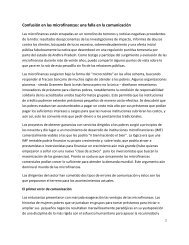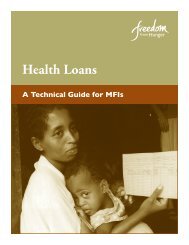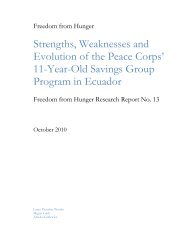Voices from the Frontlines: - Freedom from Hunger
Voices from the Frontlines: - Freedom from Hunger
Voices from the Frontlines: - Freedom from Hunger
You also want an ePaper? Increase the reach of your titles
YUMPU automatically turns print PDFs into web optimized ePapers that Google loves.
2. But product design and offerings can facilitate or strain this relationship. While much of<br />
<strong>the</strong> industry talks about meeting <strong>the</strong> needs of <strong>the</strong> poor by offering flexible products and services,<br />
<strong>the</strong> relationship with <strong>the</strong> credit officer, in this research, appears to often trump <strong>the</strong> attractiveness<br />
of products and offerings, even if <strong>the</strong> competition offers better products on paper, such as<br />
better interest rates, variety of products, etc. For example, “When I started working here, I didn’t<br />
know what I was doing but <strong>the</strong>y told me about <strong>the</strong> social aspect and it called my attention. It’s very different <strong>from</strong><br />
typical credit officer jobs and what I had imagined. We’re very well known here in <strong>the</strong> community and we go to <strong>the</strong><br />
places that are fur<strong>the</strong>st away. Everyone here knows us. Sometimes <strong>the</strong>y offer lower interest at o<strong>the</strong>r places but <strong>the</strong><br />
people still trust us.” Ano<strong>the</strong>r credit officer said, “First, I think that we give <strong>the</strong>m an opportunity. Our<br />
product doesn’t have a lot of requirements and <strong>the</strong>y like that. They like <strong>the</strong> social groups and sometimes <strong>the</strong><br />
treatment you give <strong>the</strong>m makes <strong>the</strong>m stay no matter <strong>the</strong> interest rate.” A supervisor echoed this sentiment:<br />
“The Credit with Education program is very important. The credit has a high interest rate, but if <strong>the</strong>re is a<br />
good relationship with <strong>the</strong> credit officer, <strong>the</strong> clients will come to meetings. The client is more loyal to <strong>the</strong> credit<br />
officer than to <strong>the</strong> institution. If a credit officer leaves, usually <strong>the</strong>ir clients do, too. To gain more loyalty, we should<br />
treat clients well.” Unfortunately, <strong>the</strong> questions we posed to <strong>the</strong> clients were not developed to<br />
allow us to compare <strong>the</strong> importance of <strong>the</strong> relationship with <strong>the</strong> credit officer with specific<br />
product descriptions. However, in a review of <strong>the</strong> Alsol impact stories regarding satisfaction<br />
with <strong>the</strong> institution, clients mentioned that <strong>the</strong> group structure and <strong>the</strong> willingness of <strong>the</strong> credit<br />
officer to work with <strong>the</strong>m and offer flexibility when needed were key reasons for satisfaction.<br />
Two clients interviewed actually left Alsol because of <strong>the</strong>ir poor relationship with <strong>the</strong> credit<br />
officer, because of some inappropriate behavior by <strong>the</strong> credit officer and what <strong>the</strong>y felt were<br />
false promises made by <strong>the</strong> credit officer that were never realized.<br />
<strong>Freedom</strong> <strong>from</strong> <strong>Hunger</strong> experience in applying product attribute-ranking tools with clients has<br />
shown that <strong>the</strong> relationship with <strong>the</strong> credit officer is often first or second in terms of priority. It<br />
is important to note that while we find <strong>the</strong> relationship is crucial, product design can ei<strong>the</strong>r<br />
facilitate this relationship or strain it. As <strong>the</strong> credit officers have voiced in <strong>the</strong>se interviews, many<br />
of <strong>the</strong>m wished <strong>the</strong>ir institution would lower <strong>the</strong> interest rate or provide more flexibility. For<br />
example, “Clients were happier with <strong>the</strong> old system, when <strong>the</strong>y left each loan term with all of <strong>the</strong>ir savings and<br />
we did not take any of it. We would be more competitive if we went back to that system.” Ano<strong>the</strong>r credit<br />
officer felt that <strong>the</strong> minimal group size was reducing <strong>the</strong> likelihood his groups would be<br />
successful: “It is difficult when five or six people want to form a group—<strong>the</strong> minimum is twelve—so <strong>the</strong>y will<br />
look for people to complete <strong>the</strong> group and this is hard to manage because it can bring in bad people with no trust.”<br />
Ano<strong>the</strong>r felt that “in order to ensure client loyalty, we could offer a wider range of services, such as health fairs.”<br />
A credit officer said, “If Alsol would just let me decrease <strong>the</strong> interest rate or increase capital for my good<br />
clients, my clients would be happier….” So, relationship alone will not necessarily ensure loyalty, but<br />
giving <strong>the</strong> credit officer <strong>the</strong> right tools to facilitate a positive relationship with <strong>the</strong> institution is<br />
important. Supervisors acknowledge this dynamic: “[The relationship between credit officer and client] is<br />
decisive. It determines whe<strong>the</strong>r or not <strong>the</strong> client is satisfied, and <strong>the</strong> credit officer is <strong>the</strong> direct face to <strong>the</strong> client. They<br />
support clients and help <strong>the</strong> group leadership team. The client is more loyal to <strong>the</strong> credit officer because of <strong>the</strong><br />
leadership of <strong>the</strong> credit officer. If a credit officer leaves, clients leave, too. Also, financial conditions are better in<br />
o<strong>the</strong>r institutions. To gain <strong>the</strong> loyalty of clients, [we] need to improve [our] financial conditions and eliminate <strong>the</strong><br />
<strong>Voices</strong> <strong>from</strong> <strong>the</strong> <strong>Frontlines</strong> 13















